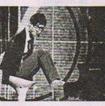短文填空根据短文内容及首字母提示,补全空格内单词,使短文完整、通顺。(请在答题卡上写出完整单词)(本大题共10小题,满分10分)Ablind boy sat on the steps of a building-九年级英语
题文
| 短文填空 根据短文内容及首字母提示,补全空格内单词,使短文完整、通顺。(请在答题卡上写出完整单词)(本大题共10小题,满分10分) A blind boy sat on the steps of a building with a hat by his feet. He held up a sign which said: “I am blind, please help.” There were only a few coins in the h 小题1: . A man was w 小题2: by. He took a few coins from his pocket and dropped them into the hat. He then took the sign, wrote some words on the other side of it. Then he put the sign back s__小题3:__ that everyone who walked by would see the new words. Soon the hat began to fill up. A lot m 小题4: people were giving money to the blind boy. That afternoon the man who had c 小题5: the sign came to see how things were. The boy recognized his footsteps and asked, “Were you the one who changed my sign this morning? What did you write?” The man said, “I only wrote the truth. I said what you said but in a d 小题6: way.” What he had written was: “Today is a beautiful day, b 小题7: I cannot see it.” Do you think the first sign and the second sign were saying the same thing? Of course b小题8: signs told people the boy was blind. But the first sign s 小题9: said the boy was blind. The second sign told people they were so l 小题10: that they were not blind. Should we be surprised that the second sign was more effective? |
答案
小题1:hat 小题2:walking 小题3: so 小题4:more 小题5:changed 小题6:different 小题7: but 小题8:both 小题9:simply 小题10:lucky |
试题分析:本文讲述了一位路人为一名盲童改牌子,从而导致两种截然不同效果的故事。 小题1:根据前面的A blind boy sat on the steps of a building with a hat by his feet可知,此处应该填hat。 小题2:根据文章的意思,和下文的everyone who walked by 可知,本处应该是一个人经过,根据前面的was可知,应该是过去进行时,故填walking。 小题3:根据前后句的关系可知,本句应该是表示目的的,根据后面的that可推知,应该是so ,与that连用,表示“为了,以便”。所以本题填so。 小题4:根据后面的people可知,此处应该是修饰people的,且是表示数量的词,根据前面的a lot可知应该填more。a lot more表示“许多,更多”。 小题5:根据下文可知,这个人就是改牌子的那个人,故应该填changed。 小题6:根据题干,本句的意思是“我只是用不同的方式说了你说的话。”“不同的”是different。 小题7:根据前句的关系,应该表示转折,故用but。本句的意思是“今天是个好天气,但我却看不到。” 小题8:通过下文对两个牌子进行了比较可知,此处应该用both。本句的意思是“当然两个牌子都能告诉人们孩子是个盲人。” 小题9:根据题干,本句的意思是“第一个牌子,只是简单的告诉人们孩子的个盲人”“单一的”是simple。 小题10:本句的意思是“第二个牌子告诉人们,他们很幸运。”故填lucky。 点评:完成本题有一定的难度,首先应该熟读文章,弄清文章的意思,注意路人给盲童改牌子的目的,以及效果;其次,应结合文意和句意选择合适的词,注意推断;再次应注意词的时态和固定用法。 |
据专家权威分析,试题“短文填空根据短文内容及首字母提示,补全空格内单词,使短文完整..”主要考查你对 物主代词,单词、词组 等考点的理解。关于这些考点的“档案”如下:
物主代词单词、词组
考点名称:物主代词
- 物主代词:
表示所有关系的代词叫做物主代词,也叫人称代词的所有格。
物主代词分为形容词性物主代词和名词性物主代词两种。
物主代词有人称和数的变化。第三人称单数的物主代词还有性别的变化。 物主代词的用法:
物主代词既有表示所属的作用又有指代作用,例如:
John had cut his finger; apparently there was a broken glass on his desk.
约翰割破了手指,显而易见,他桌子上有个破碎的玻璃杯。
物主代词有形容词性(my, your等)和名词性(mine, yours等)两种:
形容词性的物主代词属于限定词。
名词性的物主代词在用法上相当于省略了中心名词的 -'s属格结构,例如:
Jack's cap 意为 The cap is Jack's.
His cap 意为 The cap is his.形容词性物主代词用法:
1. 形容词性物主代词相当于形容词,在句中只能用作定语,后面必须跟名词。名词性物主代词常用来避免和前面已提及的名词重复。
相当于【形容词性物主代词+名词】。例如:
Is that yourbike? 那是你的自行车吗?
My pen is quite different from his.
2. 如果名词前用了形容词性物主代词,就不能再用冠词(a, an, the)、指示代词(this, that, these, those)等修饰词了。例如:
这是他的书桌。This is his desk.
3. 与形容词一起修饰名词时,形容词性物主代词要放在形容词的前面。例如:
his English books他的英语书。
their Chinese friends他们的中国朋友。
4. 汉语中经常会出现"我妈妈","你们老师"等这样的语言现象,虽然代词用的是"我"、"你们",但实际意义仍是"我的"、"你们的",
所以在英译时,注意要用形容词性物主代词"my","your"。
例如:你妈妈在家吗?
误:Is you mother at home?
正:Is yourmother at home?
5. it's与its读音相同,he's与his读音相似,但使用时需注意它们的区别(it's和he's分别是it is和he is的缩略形式,但its 和his 却是形容词性物主代词) 。
例如: It's a bird. Its name is Polly. 它是一只鸟。它的名字叫波利。
He's a student. His mother is a teacher. 他是一名学生。他妈妈是一位教师
口诀:
有“名”则"形“,无“名”则“名”。
意思是:后面是名词的话,前面就要用 形容词性物主代词。后面没有名词的话,就用名词性物主代词。名词性物主代词的句法功能:
a. 作主语,例如:
May I use your pen? Yours works better.
我可以用一用你的钢笔吗? 你的比我的好用。
b.作宾语,例如:
I love my motherland as much as you love yours.
我爱我的祖国就像你爱你的祖国一样深。
c.作介词宾语,例如:
You should interpret what I said in my sense of the word, not in yours.
你应当按我所用的词义去解释我说的话,而不能按你自己的意义去解释。
d.作主语补语,例如:
The life I have is yours. It's yours. It's yours. 我的生命属于你,属于你,属于你。
名词性物主代词可以用在介词of的后面,相当于“of+名词所有格”。
口诀
有“名”则"形“,无“名”则“名”。
注:
后面是名词的话,前面就要用 形容词性物主代词。
后面没有名词的话,就用名词性物主代词.形容词性物主代词与名词性物主代词的区别:
- 最新内容
- 相关内容
- 网友推荐
- 图文推荐
| [家长教育] 孩子为什么会和父母感情疏离? (2019-07-14) |
| [教师分享] 给远方姐姐的一封信 (2018-11-07) |
| [教师分享] 伸缩门 (2018-11-07) |
| [教师分享] 回家乡 (2018-11-07) |
| [教师分享] 是风味也是人间 (2018-11-07) |
| [教师分享] 一句格言的启示 (2018-11-07) |
| [教师分享] 无规矩不成方圆 (2018-11-07) |
| [教师分享] 第十届全国教育名家论坛有感(二) (2018-11-07) |
| [教师分享] 贪玩的小狗 (2018-11-07) |
| [教师分享] 未命名文章 (2018-11-07) |


![—______ is Jenny.—I’m Gina. Nice to meet you.[ ]A. I’mB. His nameC. I’mD. My name-七年级英语](http://www.00-edu.com/d/file/ks/4/2/wuzhudaici/2019-11-29/small48b153aa794daeb090c5d2505d5cbbac1575042450.png)



